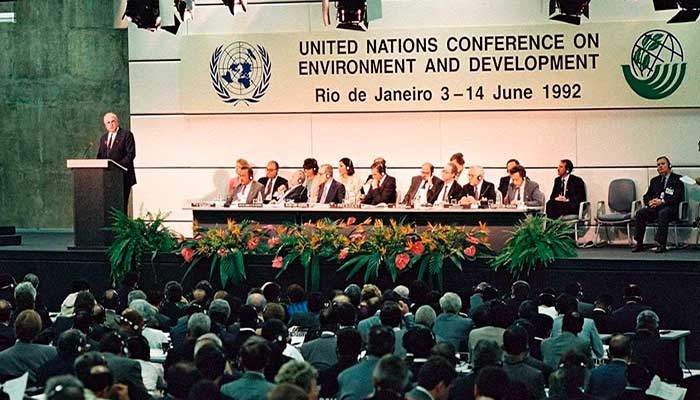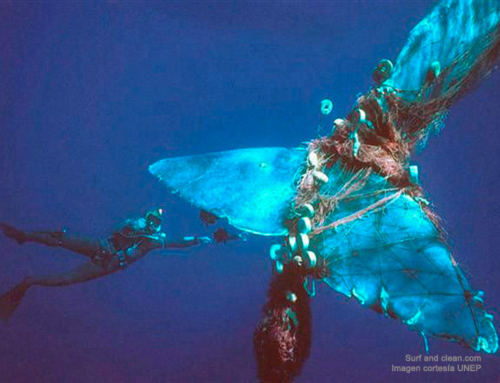Revised January 2020
The Rio Summit was a fundamental meeting, more important than most people think. In Río de Janeiro set the foundations for the fight against climate change and face the threats that loom over life on Earth, with a view to the 21st century. The United Nations Framework Convention on Climate Change (UNFCCC) was established in Rio and the creation of the COP, Conference of the Parties, was agreed as its supreme body. For those who want to get into environmental issues, global warming, climate change, etc., it is essential to obtain information on the Rio 1992 Summit.
The Second Earth Summit was held in Rio de Janeiro, Brazil, between June 3 and 14, 1992. The First Earth Summit took place in Stockholm, Sweden, 1972. The Rio meeting was organized by the UN, with Maurice Strong as his Secretary General. It was attended by 172 countries, including 108 Heads of State and Government, as well as 400 representatives of non-governmental organizations. On the other hand, some 17,000 people attended the NGO Forum, held in parallel to the Summit.
Among the objectives of the Rio Declaration we can consider the creation of a new form of cooperation between States, sectors and people, on issues related to environmental protection and sustainable economic development in harmony with the environment and cooperation between countries to protect, preserve and restore the conditions of the Earth.
Rio was the mother of climate conferences, conventions and declarations; principles relating to forests; combating desertification; conventions on biological diversity; Agenda 21 or global climate action to promote sustainable development.
However, it must also be said: most of these agreements were not binding, that is, a legal framework was not created that obliged countries or parties to comply with them. This is because, in part, that after almost thirty years have passed, most of the goals have not been achieved.
1. The Rio Declaration on Environment and Development
It consists of 27 principles. It is basically a reaffirmation of the 26 principles of the Stockholm Declaration, comparable to the Declaration of Human Rights, oriented towards the normalization of human beings relations with the environment. It was established at the First Earth Summit, also known as the “United Nations Conference on the Human Environment”, organized in 1972 on the initiative of Sweden, in conjunction with the UN.
2. The United Nations Framework Convention on Climate Change
One of the most outstanding achievements of the Rio Summit was the establishment of the United Nations Framework Convention on Climate Change (UNFCCC), which entered into force in March 1994, with the premise of strengthening public awareness worldwide on the problems related to climate change. The objectives of the UNFCCC highlight the need to stabilize greenhouse gas (GHG) concentrations in the atmosphere to prevent risks in the climate system.
3. The creation of COPs, annual climate conferences
The creation of the COP, Conference of the Parties, was agreed as the supreme organ of the UNFCCC and the association of all the countries and parties that comprise it. It would no longer be necessary to wait ten or twenty years for the next climate meeting, since it was decided that the completion of the COP would be annual, which has been held every year from then. Environmental experts, ministers, heads of state and non-governmental organizations are involved in the COP.
The last COP was COP25 organized by Chile in 2019 and held in Madrid. The next one will be COP26, which will be held in Glasgow at the end of 2020. The Paris Agreement is expected to be activated in the Scottish city.
4. Declaration of principles relating to forests
The Declaration of Principles for Sustainable Forest Management, although it has no binding legal force, provides: “All countries, especially developed countries, should strive to green the Earth through reforestation and forest conservation; that States have the right to develop their forests according to their socio-economic needs, and that financial resources should be provided to developing countries specifically aimed at establishing forest conservation programs with a view to promoting an economic and social policy of substitution”.
5. Convention to combat desertification
The problem of desertification was discussed at the Rio Summit, which has been taking alarming characteristics for some time. In Rio, he advanced on how to deal with the problem and supported a new integrated approach to it. It entered into force on December 26, 1996.” The extensive UN document, “United Nations Convention to Combat Desertification in Countries Affected by Severe Drought or Desertification, in particular in Africa”, consists of 6 parts, 40 articles and dozens of sections and numerals.
6. Convention on Biological Diversity
The Convention on Biological Diversity (CBD) is a legally binding international treaty with three main objectives: “the conservation of biological diversity, the sustainable use of its components and the fair and equitable sharing of the benefits derived from the use of genetic resources Its overall objective is to promote measures that lead to a sustainable future.”
7. Program 21. Global action plan to promote sustainable development.
Program 21, also known as Agenda 21, contains more than 2,500 practical recommendations. It addresses the most urgent problems. “Its objective is to prepare the world for the challenges of the next century. It includes concrete proposals on social and economic issues, such as the fight against poverty, the evolution of production and consumption models, demographic dynamics, conservation and management of our natural resources, protection of the atmosphere, oceans and diversity. biological, the prevention of deforestation and the promotion of sustainable agriculture.”
Criticisms of the Rio Summit
In a long article entitled “The discreet charm of the Earth’s summit. Impressionist evaluation of Rio 92”, written after the Summit by Roberto Guimaraes, the Brazilian political scientist, researcher at the Social Development Division of the United Nations Economic Commission for Latin America and the Caribbean (ECLAC), states:
“In general terms, all the agreements adopted in Rio-92 produced more frustration than satisfaction among observers. The climate change convention, for example, was the most expected document of the conference; and not without reason, since the convention had originally been formulated to eliminate, or at least slow down, the processes that contribute to the increase in the average temperatures of the atmosphere and the increase in the level of the oceans, thus avoiding negative impacts for Agriculture and coastal areas. The high expectations regarding this convention are only comparable with the level of widespread frustration with which the final text has been received. It constitutes, in fact, the biggest failure of Rio. His text has been so “diluted” in previous discussions, that the document finally approved lost much of its original strength, and more closely resembles a simple statement of intent. Instead of taking urgent measures in that area, the current text only “recommends” the stabilization of carbon dioxide (CO2) emissions at the levels existing in 1990. Even so, it does not set deadlines for such stabilization to take effect.”
Other evidence that the commitments made at climate conferences are not fulfilled
The constant increase in world temperature
The PPM, parts per million of carbon dioxide, present in the atmosphere for hundreds of millions of years, have produced the natural greenhouse effect of the Earth, a characteristic that has allowed life on our planet, due to its quality of maintaining a fairly constant temperature. But anthropogenic CO2 emissions increase the amount of PPM in the atmosphere in an unnatural way, increasing global warming and its effect on climate change. In this 21st century alone, the world temperature has set 17 records for this cause.
The continuous increase of PPM in the atmosphere
PPMs in the atmosphere have not stopped growing in almost three centuries and especially since the end of World War II.
In 1750, at the beginning of the Industrial Revolution, they were accounted for at 280 PPM. At the time of the Stockholm Conference, in 1972, they were at 330 PPM. Twenty years later, during the Rio-92 Summit it had already reached 360 PPM. The 400 PPM psychological brand broke down in 2016 and has since risen to 415 PPM, a figure from May 19, 2019, provided by the Mauna Loa Observatory, based in Hawaii. Increases like these had not happened on Earth for millions of years. As long as PPMs continue to increase, the temperatures so will it.
Conclusions:
We must conclude that most of the objectives of the Rio Summit have not been achieved. When we write this, left barely ten months left before the activation of the Paris Agreement. As much as the UN, NGOs and other entities strive with their good intentions to reverse climate change and its adverse effects, for now they have found it difficult to turn their intentions into realities. This is due, mainly, to the resistance to change of part of the great interests, permanent brakes and retaining walls before any action that affects their assets.
The figures mentioned two paragraphs above clearly demonstrate that the large CO2 emitters have not done the task assigned in climate conferences over a quarter of a century. Nor have those countries that base their economy on coal, oil and natural gas, and do not want to stop producing these fossil fuels. No doubt they are primarily responsible for the climatic situation of the Earth. However, we still have time to reverse it. The production of electric cars, wind energy and solar energy are increasing. As the manufacturing of these increases further, the costs of electromobility, wind turbines and photovoltaic panels will be reduced. This will make fossil fuels less competitive, at the same time that the coal and hydrocarbon markets will become smaller.
Sandor Alejandro Gerendas-Kiss







Leave A Comment